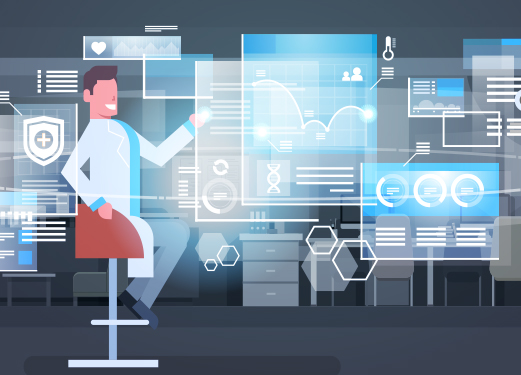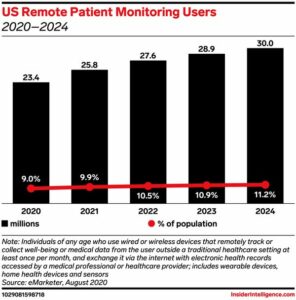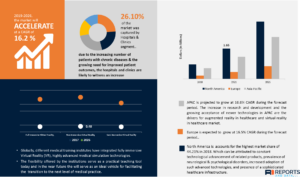
Healthcare is undergoing rapid transformation, and the introduction of digital services has been a significant catalyst. ‘Care anywhere’ will be a critical aspect over the next few decades. Accordingly, healthcare providers need to up their game to create a hassle-free digital experience for the patients.
While digital healthcare technologies have existed for some time, the pace of their evolution and adoption has ramped up due to the pandemic. Advanced Cloud tools are being used in a majority of healthcare processes to get better patient outcomes.
In this blog, we take a look at some of the tools that we believe will help healthcare providers, payers, and patients ride the digital transformation wave.
According to the Accenture Digital Health Technology Vision 2021 report, 81% of healthcare executives say the pace of digital transformation for their organization is accelerating, and 93% report that they are innovating with a sense of urgency and call to action this year.
Remote Patient Monitoring (RPM) and Virtual Consultation Tools
Thanks to RPM and virtual consultations, patients can now receive the same level of care at home as they would in an outpatient clinic. Telehealth has shown that remote consultations are convenient and often preferred.
According to research from Insider Intelligence, by 2024, remote patient monitoring services and tools are expected to reach 30 million U.S. patients.

Click to view enlarged version
The advantages of RPM and virtual consultations are many, including:
- It gives patients more control over their health by teaching them how to manage their care and when to seek help.
- It enables physicians to track chronic disease conditions by identifying red flags and intervening before it’s too late.
- It gives providers faster access to the verified patient data right at the moment of emergency or treatment struggles.
- It encourages cost savings with fewer hospital readmissions, less in-person visits, and reduced readmission penalties.
Read: Cloud Platform Providers Making Remote Patient Monitoring Easy
Wearables and Sensors
Wearables and sensors help patients to keep track of their health data and take basic precautions when required. They have become an essential facilitator in providing clinicians with actionable health insights.
There are various advantages of using wearable technology in healthcare:
- It promotes preventative healthcare by recognizing health imbalances and emergencies.
- One device performs several functions, such as bio-sensors monitoring heart rate and respiratory rate.
- Healthcare providers can track patient data on day-to-day basis to make more accurate diagnoses.
- These systems enable hands-free interaction in sterile environment.
Artificial Intelligence (AI) based Healthcare Tools
Artificial intelligence in healthcare refers to the employment of complicated algorithms that automate specific healthcare tasks. Robotics and AI are changing the healthcare system by providing patients with modern, patient-friendly care.
The following are the benefits that AI brings to the table:
- Personalization of care depending on the activity and physiological needs of the patient.
- Better clinical outcomes from in-depth insights gathered from various data sources.
- The ability to avoid life-threatening emergencies by monitoring and warning patients in real-time.
- Optimized hospital workflow to prioritize patient care.
Blockchain-based Electronic Health Records (EHR)
EHR streamlines care workflow by digitizing the patient’s paper chart. EHRs are patient-centered, real-time clinical records that can be accessed and updated by authorized health experts. Blockchain could transform the storage and sharing of a patient’s electronic health record.
Blockchain-based EHR beats a traditional health record system due to the following benefits:
- Providing security and privacy by giving patients authority over their data.
- Promoting data interoperability by centralizing records from many sources.
- Assuring smooth reimbursements for patients and lowering administrative costs for hospitals.
- Encouraging data transparency by making updates visible to all authorized members.
Augmented Reality (AR) Virtual Reality (VR) in Healthcare
VR/AR technology is advancing, and organizations are leveraging it in novel ways to improve human health. Using VR simulations in the hospital can help clinicians relate with their patients efficiently.
According to a new report by Reports and Data, the VR Healthcare Market size is estimated to reach USD 7.86 Billion by 2028.

Click to view enlarged version
AR and VR are being used in healthcare for several activities, including:
- Diagnoses and treatment of dementia, depression, PTSD, and other physical disorders and pathologies.
- Efficient and effective remote diagnosis and surgery.
- Training hospital staff for various medical procedures and high-risk situations.
- Educating patients about complex medical procedures in an engaging way.
As the demand for healthcare facilities grows, so will the quality of patient care. Technology will play a crucial role in making modern healthcare accessible to all sections of the population.
The future seems bright, and we can’t wait to see how healthcare organizations will use these technologies to stay up to date with new age of digitalization.
What are your recommendations on tools that are revolutionizing healthcare?
Do share your thoughts through the comments section below or drop us a line at contact@harbingergroup.com.






